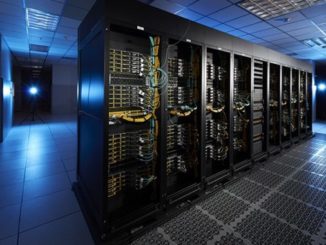
Computing has become more complex as the digital age has progressed. In the early days, companies had a central machine or a collection of them doing all of their processing, and then clients like PCs and then smartphones got smart and some of the work of these central processors was offloaded to them. These days, the datacenter is becoming more effusive and pervasive, with tiers of computing reaching out from the center through the cloud and out to the edge, and all manner of new devices are springing up, feeding into these processing tiers and sometimes also feeding off of them.
It is hard sometimes to tell the clients from the servers. And perhaps the point is that these distinctions are arbitrary and relative in a massively networked world.
What we can say, from the perspective of aggregations of data processing and storage, is that there really is not going to be a kind of exclusive hybrid computing as such. That means hybrid in the sense of a mix of on-premises equipment mixed with compute and storage running in a public cloud as well as hybrid in the sense of running across multiple public clouds – or a mix of the two. Given that the edge is evolving into a new tier, perhaps we should coin a new term to describe this, and hybrid is not the right word given it connotation as a mongrel with a certain kind of vigor, from the Latin ibrida and specifically meaning what you get when a wild boar has offspring with a tame sow. Then again, that may be an apt description. . . .
In any event, hybrid is the term that people will use, and it will mean computing in many of these different ways. And the important thing is that companies will want to have many different ways to compose and consume their compute and storage, but the one thing they will not want to do is have a unique way to configure and manage each style of compute and storage. The complexity will be too much to cope with.
“It is still early days for the edge,” Bill Wagner, chief executive officer at Bright Computing, tell The Next Platform. “Our view is largely informed by what we are seeing from our customers, who are thinking through use cases and looking at datasets and where processing is occurring, and they haven’t really thought through the entire workflow yet. We think, as they do, that the edge becomes much more integral to the overall infrastructure that an organization is planning, and that as a result, the definition of hybrid is evolving yet again.”
The nuance that Wagner sees is that the datacenter, the public cloud, and the edge are distinct in terms of the infrastructure that is running in each area, and the challenges of building, operating, and managing each tier of compute and storage are slightly different, but that tools like Bright Cluster Manager can be a unifying substrate for all of the different tiers that organizations decide to adopt.
This is a parallel approach to what the public cloud providers are taking with the edge, says Wagner, but no one would call what these companies are doing more open as they reach over to the datacenter with AWS Outposts, Microsoft Azure Stack, or Google Anthos infrastructure and out to the edge with smaller implementations of these stacks. It is really just more of the same lock-in.
“The public cloud providers are building an interface layer that can manage on premises infrastructure with the same interface that their customers use to access their respective clouds and then they are providing the same interface to edge facilities that they’re building or partnering to create,” says Wagner. “While it’s important for organizations to have a single interface for their hybrid computing infrastructure, they need to think about who controls that interface and the potential of lock-in, especially with data residing outside of their organizations. Where Bright Computing fits in is that we give you the ability to provision and manage your hybrid infrastructure through a single interface, abstracting the underlying technologies and allowing you to use different types of servers, cloud providers or technologies. If you go with one of the cloud providers to manage your hybrid infrastructure, you have to be confident about the direction they may take in the future and how that may restrict your options and flexibility”.
One thing to consider is that while edge compute and storage looks a lot like datacenter gear in many cases today, this may not be true in the future.
“Given that the landscape at the edge is evolving pretty rapidly, the edge servers of the future might be very distinct from the OEM and ODM devices we are used to in the datacenter and in the cloud, and depending on how the edge evolves in different environments and use cases, different from each other, too,”
Wagner believes. “We don’t really know how that is going to evolve. We are all speculating because we don’t know how this is all going to play out, but we do know that Kubernetes and containers is likely to play everywhere – eventually.”
For the sake of quickly getting started, some organizations might, for instance, go all-in with Amazon Web Services or Microsoft Azure, or Google Anthos, maybe running Kubernetes controllers and containers on premises, in the cloud, or at the edge, with a mix of bare metal here and there with, we think, perhaps, a DPU abstracting the compute, network, storage, and security away from the servers. When organizations go that route, says Wagner, they’re doing so because it’s easier and they can shed the burden of making many choices or supporting different approaches. Some companies will place that bet, despite the potential risk of being locked-in.
Others will pick technologies and approaches for different tiers of compute and storage, and mix and match, and try to find a common denominator across on premises, public cloud, and edge, and still others might just keep silos across public clouds or across compute tiers, regardless of how much they don’t want them. That certainly has been the history of servers over the past five decades. A common substrate – the X86 server – will be an anomaly for a short period of time as new processors accelerators that suit different needs in the edge-to-core-to-cloud hybrid model become increasingly pervasive.
The beautiful thing is that no matter which computing tiers, technologies or cloud providers an organization wants to use, Wagner says Bright Computing can automate provisioning and managing infrastructure across the emerging tiers of hybrid through a single interface, and it does not need to do a lot of missionary selling to convince customers that they need to keep all of their options open. They can start with one tier using Bright, and as they need to add tiers that use different types of servers, processors or cloud providers, they can manage those additional tiers from the same Bright interface.





Hiya TPM! So why do you describe the datacenter as getting more “effusive”???